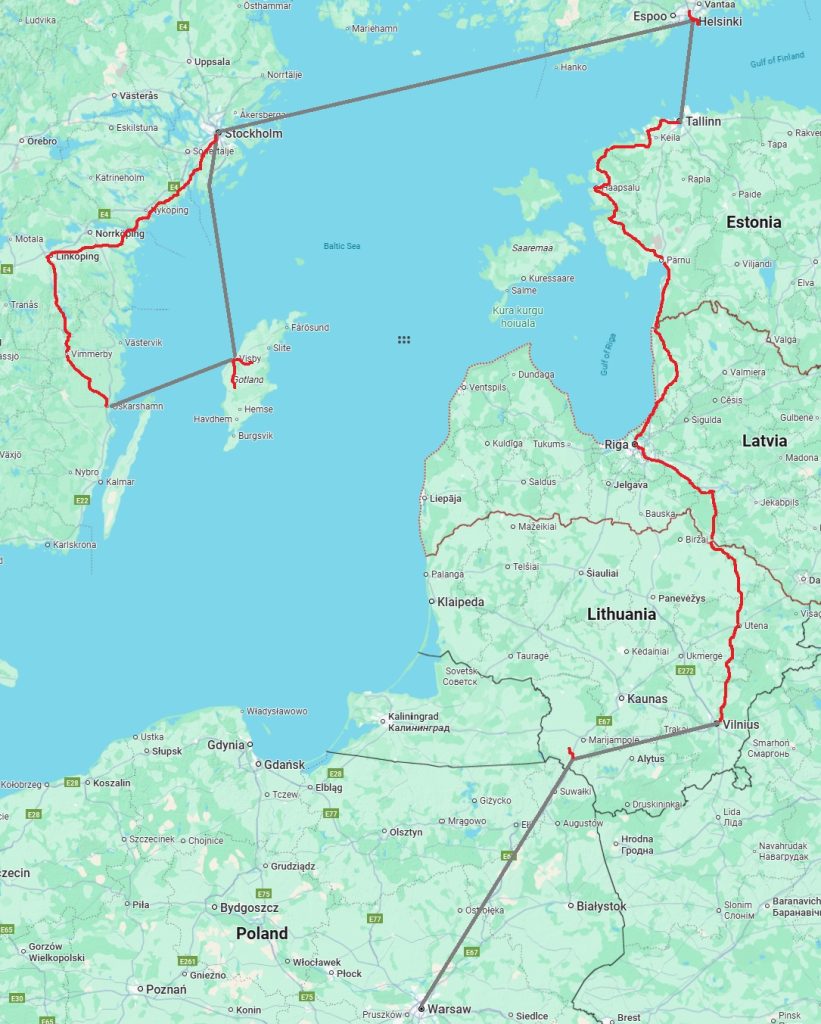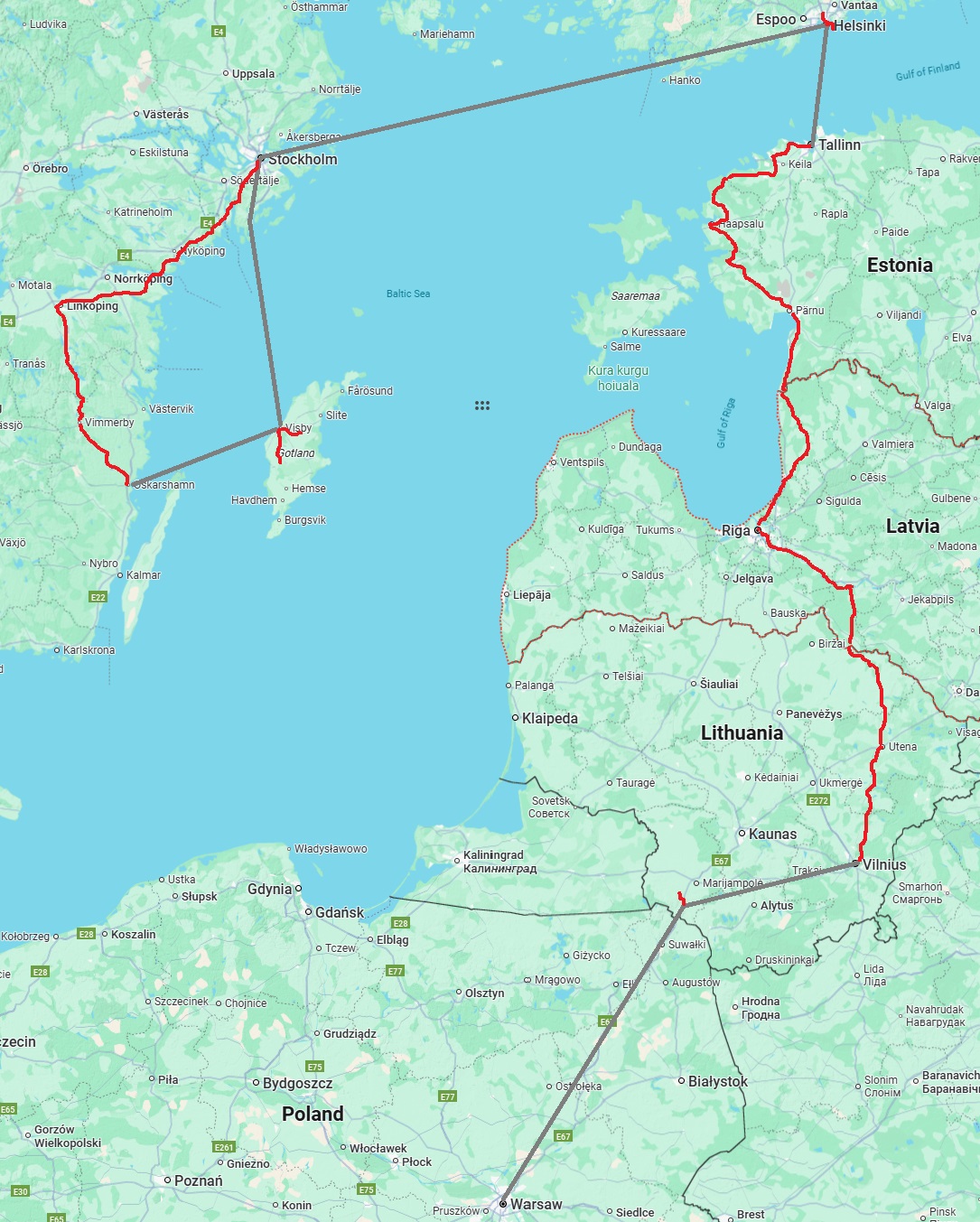First, the numbers. We flew out July 24, and I traveled for 36 nights. My flight home began August 29, and then a missed flight lead to my return on August 30 (and my bicycle August 31!). Linda and I went our separate ways on August 8, her to a farm in Sweden and then Norway, me to a ferry to Helsinki and then Tallinn. I had planned to spend a little more time in Latvia, but I turned south into Lithuania earlier than planned to get at least nominally better roads.
Sweden: 14 nights (with Linda)
Finland: 1 night (but 2 days)
Estonia: 4 nights (but 5 days)
Latvia: 5 nights
Lithuania: 6 nights
Poland (Warsaw): 3 nights
France (Paris): 1 (inadvertently)
(that nights don’t completely line up, as I had two nights on a ferry).
I spent 13 days not cycling (or cycling < 10 km from one place to another), caused in part by our extended stay on Gotland. 1,542 km cycled (561 km for Linda) – an average of 42 km / day total, or 67 km / day for days that I rode. I rode 152 km on my longest day thanks to flat terrain, a but of a tailwind, and poor choices on my part, a distance that put the day in about the top 5 days ever. Days cycling tended to be either ~60 km, or > 100 km. I had planned this trip as an average of 60 km / day, and I need to remember that an average 50 km/day provides a less rushed experience.
I spent 8 nights in hotels, 10 nights in B&Bs, 4 nights camping, and 12 nights in hostels (and 2 nights on ferries) – a far cry from my usual 40% camping / 40% hostels/ 20% other. Part of that derives from Linda not wanting to camp, and part from me occasionally ducking nightly rain by staying not in a tent (or failing to find a campground where I wanted one).
A number of the hostels didn’t really meet my definition of “hostel”. At the core, a hostel is shared accommodation, which they theoretically met except I’d be in a room (or even an entire hostel) by myself, and I really do enjoy staying in shared space with other travelers. However, many of them didn’t have a shared common area or a shared kitchen. The default hostel also typically includes a Front Desk for information, not just a passcode for the lock. The big hostels typically include laundry services. The nicest hostels definitely include Riga (which included an option to camp), and Vilnius (the only hostel I’ve stayed in above a McDonald’s!).
My overall expenses (not counting core travel of flights and the ferry to Finland) were $3,177 for 36 nights. $88 / night (my average / night when travelling alone was only $60). Even so, that is, for me, extraordinarily high. I can attribute that to several factors.
First, of course is the Sweden portion traveling with Linda. We also got tagged by illness causing an additional night’s stay in the most expensive places we stayed ($184), requiring us to also throw away a reservation one night ahead. I managed to not catch that illness from her, but caught something a day out or Vilnius which just left me feeling run-down for the rest of the trip (more than run down actually, as the medication left me a little disoriented).
I also spent far fewer nights camping than usual, causing both an obvious increase in accommodation cost, as well as an indirect increase in food cost. I wasn’t cooking for myself from a hotel (and generally wasn’t cooking for myself in the AirB&Bs or hostels either). While I expected the Baltics (Estonia, Latvia, and Lithuania) to be less expensive, they weren’t that much less expensive. They’ve also clearly identified tourism as a source of revenue; even churches charged ~ $10 for a visit (which in turn caused me to not visit a lot of them). I spent over $60 in one day visiting various things in Tallinn. Abandoned castles in fields are much cheaper!
Gear
We didn’t lose any gear at all, which might be a first for me. Airport security confiscated a tube of sun screen on the way home.
I had worried whether I carried a large enough USB battery, but 10,000 mAh worked out fine. Staying mainly in hotels/B&Bs certainly made recharging easier. The zipper on my tent was failing, although I learned where the weak point was and worked around it. This was the (used) replacement tent for my previous Mountain Hardwear SMUL; I hadn’t noticed the failing zipper when I checked its condition. The new rain jacket performed admirably, although fortunately I didn’t have a lot of opportunity to test it. I need to purchase the hood designed to work with it instead of the one from my old rain jacket. I had wider tires on my bicycle than usual (700×35 in front, 700×37 in back); not good enough for the Baltics, but glad I had them. The bicycle computer freaked out twice, suddenly deciding I was riding 105 kph; not really an issue but made me have to do more math at the end. I had forgotten the last time I’d replaced my rear cassette I’d used a 32-tooth instead of a 36-tooth. Most of the route was flat, but there were a few days I would have been happier with more climbing range, especially those times Linda was zooming up a hill.
Linda considers renting the e-bike a complete success. It gave her the ability to keep up (too much the first couple of days as we worked out how to manage her speed). Linda commented it was probably good that we were going our separate ways at the end of two weeks. By the end of our time in Sweden, my metabolism was ramping up; for Linda to keep up she was using 3-4 bars on her e-bike instead of 2 bars. She never ran out of power, and in fact always had a good margin left. Even the 110 km day she ended with 2 of the 5 bars for power.
Health
At one point in time or another both Linda and I were sick (although not at the same time). Linda was better after a day of rest. Even a week after I got home I still have the remnants of the cough. On the bright side the cold medicine did a great job of controlling my cough.
But my knee was the real problem. Even before the trip my knee has been doing something new – it sometimes catches, which is both painful and makes me unstable. I must be able to tell it’s coming, as I usually wonder about my knee about 10 seconds before it catches. At the VERY last minute before the trip I managed to get a cortisone injection, which I don’t know if it helped or not.
My knee is normally just fine for cycling as long as I don’t push too hard. However, with the road quality I spent a lot of time using leg and arm strength to control the bicycle as it slid around, which put torque on my knee. By the time I arrived in Vilnius my knee hurt all the time. Even before then I knew it needed a break, between road quality and feeling “behind”, I just couldn’t give it one. There were many reasons I didn’t ride from Vilnius to Mockava: the weather forecast, bad roads, no direct route. But primarily the knee just needed a break.
Summary
“So how was your trip?”
The first day with Linda zooming off drove me crazy, but by the end of the second day we’d worked that out, and from there our time in Sweden was lovely. Cycling in the Baltics on the other hand I found … unpleasant. Between roads and traffic I had more than one day I questioned my survival. I think it would have helped if I’d given myself more time. All in all by the time I got to Latvia I felt quite rushed (not to mention being VERY tired of loose gravel).
We had great weather almost the entire trip. Although a few days were in the high 80s, almost all of them had a high in the low 60s and a low in the low 50s – perfect weather for cycling. If I’d been willing to wait at the train station that last cycling day in Mockova the trip could have had zero days of getting wet from the rain.
Where next? I’ve had a friend offer to help set me up for a Taiwan trip early next year. I noticed on my map that there’s a clear line from Berlin (one of the few capitols in Europe I haven’t been to) to Slovakia, and the cycle route for the first part of that is well-developed Eurovelo.
Thanks for joining us on our adventure.


